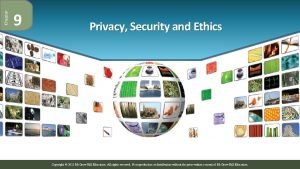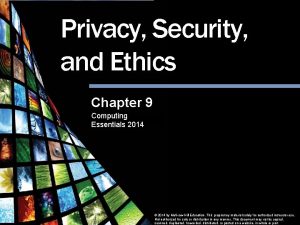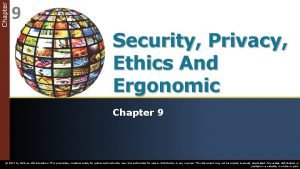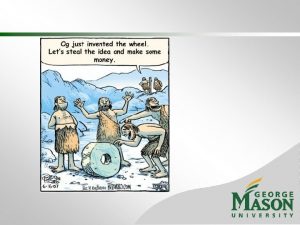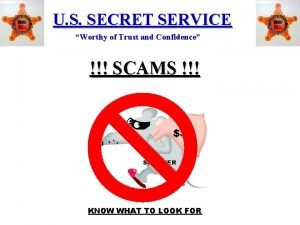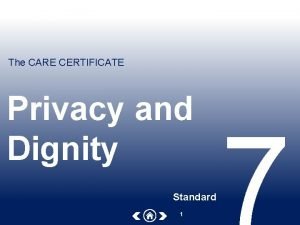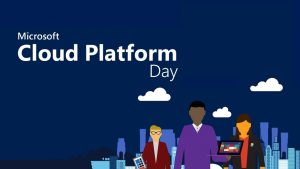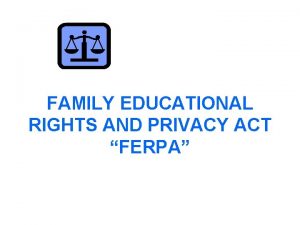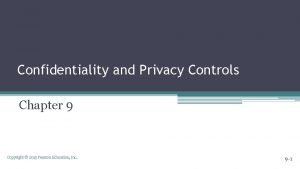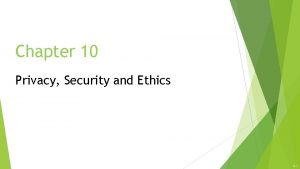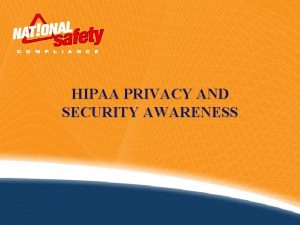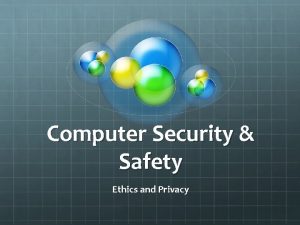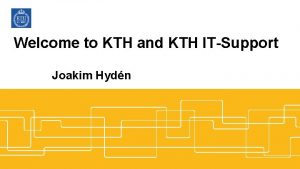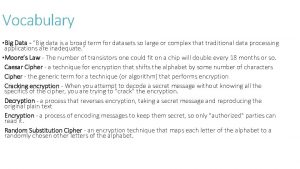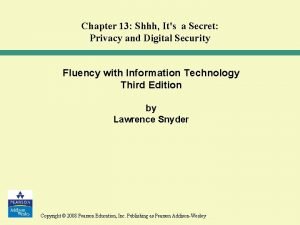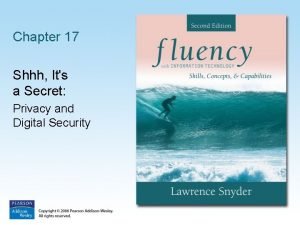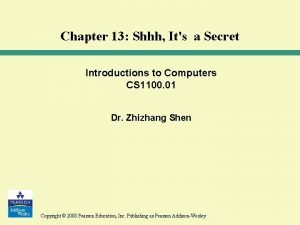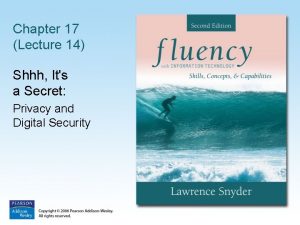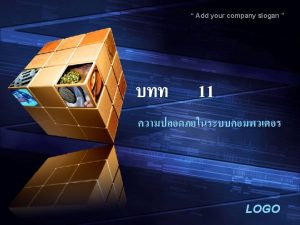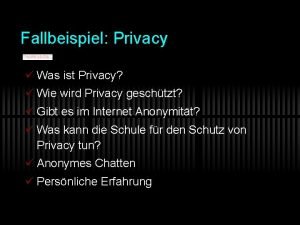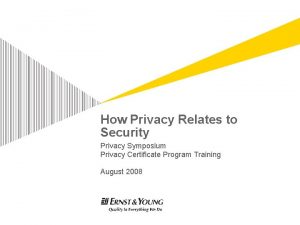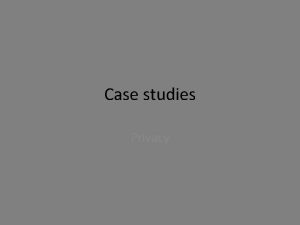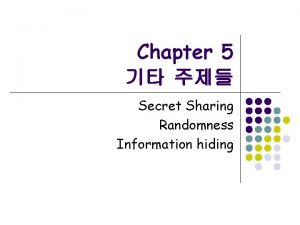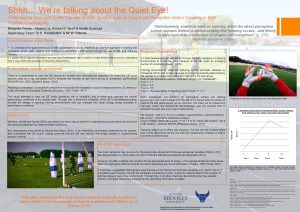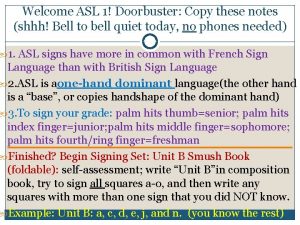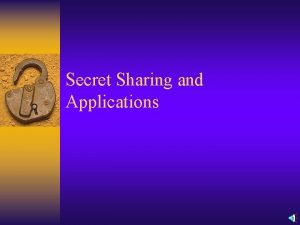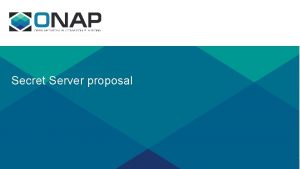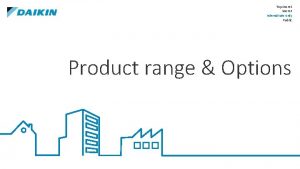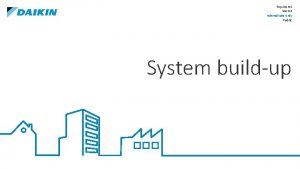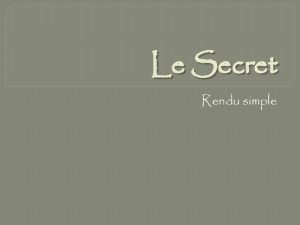Chapter 17 Shhh Its a Secret Privacy and


































- Slides: 34

Chapter 17 Shhh, It's a Secret: Privacy and Digital Security

Privacy: Whose Information Is It? • What is privacy? Examine a transaction of buying Dating for Total Dummies – Information linking the purchase with the customer • How can the information be used? – Book merchant collecting information is ordinary business practice – Book merchant sending advertisements to customer is ordinary business practice – What about merchant selling information to other businesses? Copyright © 2006 Pearson Addison-Wesley. All rights reserved. 2

Modern Devices and Privacy • Modern devices make it possible to violate people's privacy without their knowledge • In 1890, Brandeis wrote that individuals deserve "sufficient safeguards against improper circulation" of their images Copyright © 2006 Pearson Addison-Wesley. All rights reserved. 3

Controlling the Use of Information • Spectrum of control spans four main possibilities: 1. No uses. Information should be deleted when the store is finished with it 2. Approval or Opt-in. Store can use it for other purposes with customer's approval 3. Objection or Opt-out. Store can use it for other purposes if customer does not object 4. No limits. Information can be used any way the store chooses 5. Fifth possibility is internal use—store can use information to continue conducting business with you Copyright © 2006 Pearson Addison-Wesley. All rights reserved. 4

A Privacy Definition • Privacy: The right of people to choose freely under what circumstances and to what extent they will reveal themselves, their attitude, and their behavior to others • Threats to Privacy: Government and business • Voluntary Disclosure: We choose to reveal information in return for real benefits (doctor, credit card company) Copyright © 2006 Pearson Addison-Wesley. All rights reserved. 5

Fair Information Practices • OECD (Organization of Economic Cooperation and Development) in 1980 developed the standard eight-point list of privacy principles. – – – – Limited Collection Principle Quality Principle Purpose Principle Use Limitation Principle Security Principle Openness Principle Participation Principle Accountability Principle Copyright © 2006 Pearson Addison-Wesley. All rights reserved. 6

Comparing Privacy Across the Atlantic • U. S. has not adopted OECD principles • China does not protect privacy • European Union has European Data Protection Directive (OECD principles) • EU Directive requires data on EU citizens to be protected at same standard even when it leaves their country Copyright © 2006 Pearson Addison-Wesley. All rights reserved. 7

US Laws Protecting Privacy • Privacy Act of 1974 covers interaction with government • Interactions with business: – Electronic Communication Privacy Act of 1986 – Video Privacy Protection Act of 1988 – Telephone Consumer Protection Act of 1991 – Driver's Privacy Protection Act of 1994 • These all deal with specific business sectors— not an omnibus solution Copyright © 2006 Pearson Addison-Wesley. All rights reserved. 8

Privacy Principles: European Union • Two points of disagreement between FTC (US) and OECD (Europe): – Opt-in/Opt-out • When can an organization use information it collects for one purpose, for a different purpose? • Opt-out is US standard except for highly sensitive data; Opt-in is European standard – Compliance/Enforcement • US has "voluntary compliance, " EU has offices to control data Copyright © 2006 Pearson Addison-Wesley. All rights reserved. 9

A Privacy Success Story • Do-Not-Call List – Telemarketing industry's "self-policing" mechanism required individuals to write a letter or make an on-line payment to stop telemarketing calls – US government set up Do Not Call List. 80, 000 households are on the list and telemarketing industry has largely collapsed Copyright © 2006 Pearson Addison-Wesley. All rights reserved. 10

The Cookie Monster • Cookie: Record containing seven fields of information that uniquely identify a customer's session on a website. Cookie is stored on customer's hard drive. • Abuse: Third party cookie – Third party advertisers on web site enter client/server relationship with customer as page loads – Advertiser can set cookies, and can access cookies when user views other websites that advertiser uses Copyright © 2006 Pearson Addison-Wesley. All rights reserved. 11

The Cookie Monster (Cont'd) • Browser options: – Turn off cookies – Ask each time a server wants to set a cookie – Accept all cookies Copyright © 2006 Pearson Addison-Wesley. All rights reserved. 12

Copyright © 2006 Pearson Addison-Wesley. All rights reserved. 13

Identity Theft • Americans do not enjoy Security Principle • Identity theft is the crime of posing as someone else for fraudulent purposes – Using information about person like credit card numbers, social security numbers Copyright © 2006 Pearson Addison-Wesley. All rights reserved. 14

Managing Your Privacy • Purchase up-to-date virus checking software • Adjust your cookie preferences to match your comfort level • Read the privacy statement of any website you give information to • Review protections against phishing scams Copyright © 2006 Pearson Addison-Wesley. All rights reserved. 15

Managing Your Privacy (cont'd) • Patronize reputable companies for music, software, etc. • Be skeptical • Stay familiar with current assaults on privacy • Lobby for US adoption of Fair Information Practices Copyright © 2006 Pearson Addison-Wesley. All rights reserved. 16

Encryption And Decryption • Encryption Terminology – Encryption: Transform representation so it is no longer understandable – Cryptosystem: A combination of encryption and decryption methods – Cleartext or Plaintext: Information before encryption – Cipher text: Information in encrypted form – One-way cipher: Encryption system that cannot be easily reversed (used for passwords) – Decryption: Reversing encryption process Copyright © 2006 Pearson Addison-Wesley. All rights reserved. 17

Copyright © 2006 Pearson Addison-Wesley. All rights reserved. 18

XOR: An Encryption Operation • Exclusive OR: Interesting way to apply a key to cleartext • Combines two bits by rule: If the bits are the same, the result is 0; if the bits are different, the result is 1 • XOR is its own inverse Copyright © 2006 Pearson Addison-Wesley. All rights reserved. 19

Encrypting a Message • Two students writing messages to each other decide to encrypt them • Key is 0001 0111 0010 1101 • They use XOR encryption • First write down ASCII representation of the letters in pairs • XOR each resulting 16 -bit sequence with their key • If any bit sequence is XORed with another bit sequence and the result is XORed again with the same key, the result is the original bit sequence • It makes no difference if the key is on the left or right Copyright © 2006 Pearson Addison-Wesley. All rights reserved. 20

Copyright © 2006 Pearson Addison-Wesley. All rights reserved. 21

Breaking the Code • Longer text is easier to decode – Notice what bit sequences show up frequently – Knowledge of most frequent letters in the cleartext language • Smarter byte-for-byte substitutions – Group more than two bytes – Be sure not to exchange the key over unsecured connection Copyright © 2006 Pearson Addison-Wesley. All rights reserved. 22

Public Key Cryptosystems • People who want to receive information securely publish a key that senders should use to encrypt messages • Key is chosen so only receiver can decode Copyright © 2006 Pearson Addison-Wesley. All rights reserved. 23

Code Cracker's Problem • How is it secure when the key is published? • All that was sent was the remainder • So how can the receiver decrypt? Copyright © 2006 Pearson Addison-Wesley. All rights reserved. 24

RSA Public Key Cryptosystem • Relies on prime numbers • Any number can be factored into primes in only one way • Choosing a Key: – Key has special properties • Must be the product of two different prime numbers, p and q • p and q must be about 64 or 65 digits long to produce a 129 -digit public key • p and q must also be 2 greater than a multiple of 3 Copyright © 2006 Pearson Addison-Wesley. All rights reserved. 25

Encrypting a Message • Divide cleartext into blocks, cube the blocks, divide them by the public key, and transmit the remainders from the divisions Copyright © 2006 Pearson Addison-Wesley. All rights reserved. 26

The Decryption Method • Compute the quantity • If the cipher text numbers C are each raised to the s power, Cs, and divided by the key KR, the remainders are the cleartext • For quotient c: – Cs = K R * c + T Copyright © 2006 Pearson Addison-Wesley. All rights reserved. 27

Summarizing the RSA System • Three steps: – Publishing – Encrypting – Decrypting • As long as p, q, and s are kept secret, code can't be cracked – If the key is large enough, factoring to find p and q can't be done in any reasonable amount of time even by software Copyright © 2006 Pearson Addison-Wesley. All rights reserved. 28

Strong Encryption Techniques • A communicating party can use the technology to protect their communication so no one else can read it, period • Government agencies would like this technology kept out of the hands of "bad guys" • What if cryptography software vendors had to give government a way to break such codes? Copyright © 2006 Pearson Addison-Wesley. All rights reserved. 29

Strong Encryption Techniques • Trapdoor Technique: – Way to bypass security while software is encrypting the cleartext. Send cleartext to lawenforcement officials when cipher text is sent. • Key escrow: – Require software to register key with a third party, who holds it in confidence. If there is a need to break the code, the third party provides the key. • These two schemes could be abused Copyright © 2006 Pearson Addison-Wesley. All rights reserved. 30

Redundancy Is Very, Very Good • Precautions against data disasters include backups and system redundancy (having a hot spare up and running) Copyright © 2006 Pearson Addison-Wesley. All rights reserved. 31

A Fault Recovery Program for Business • Keep a full copy of everything written on the system as of some date and time—full backup • Create partial backups—copies of changes since last full backup • After disaster, start by installing the last full backup copy • Re-create state of system by making changes stored in partial backups, in order • All data since last backup (full or partial) will be lost Copyright © 2006 Pearson Addison-Wesley. All rights reserved. 32

Backing Up a Personal Computer • How and What to Back Up – You can buy automatic backup software that writes to zip drive or writeable CD – For manual backups, you do not have to backup data that • Can be re-created from some permanent source, like software • Was saved before but has not changed • You don’t care about Copyright © 2006 Pearson Addison-Wesley. All rights reserved. 33

Recovering Deleted Information • Backups also protect from accidental deletions • Can save evidence of crime or other inappropriate behavior • Remember that two copies of email are produced when sender hits send—one in sent mail file and one somewhere else, which the sender probably can't delete Copyright © 2006 Pearson Addison-Wesley. All rights reserved. 34
 Privacy awareness and hipaa privacy training cvs answers
Privacy awareness and hipaa privacy training cvs answers Chapter 9 privacy security and ethics
Chapter 9 privacy security and ethics Chapter 9 privacy security and ethics
Chapter 9 privacy security and ethics Chapter 9 privacy security and ethics
Chapter 9 privacy security and ethics Secret life of bees characterization
Secret life of bees characterization Your secret keeper chapter 12
Your secret keeper chapter 12 The emigree
The emigree Its halloween its halloween the moon is full and bright
Its halloween its halloween the moon is full and bright Trademark and trade secret
Trademark and trade secret Inkagames
Inkagames Here comes charlie chapter 1
Here comes charlie chapter 1 Examples of little foxes that spoil the vine
Examples of little foxes that spoil the vine Lila and the secret of rain
Lila and the secret of rain @gloss_3179:https://youtu.be/b2wispv4qts
@gloss_3179:https://youtu.be/b2wispv4qts Yang the second and her secret admirers
Yang the second and her secret admirers Secret service worthy of trust and confidence
Secret service worthy of trust and confidence When a train increases its velocity its momentum
When a train increases its velocity its momentum Windy cloudy rainy sunny
Windy cloudy rainy sunny If its square its a sonnet summary
If its square its a sonnet summary Its not easy but its worth it
Its not easy but its worth it Privacy and dignity in care
Privacy and dignity in care Azure pci dss responsibility matrix
Azure pci dss responsibility matrix Ferpa violation
Ferpa violation Family educational rights and privacy act of 1974
Family educational rights and privacy act of 1974 Confidentiality and privacy controls
Confidentiality and privacy controls Three primary privacy issues are accuracy property and
Three primary privacy issues are accuracy property and Hipaa privacy and security awareness training
Hipaa privacy and security awareness training Cyberextortionist definition
Cyberextortionist definition Network secret kth
Network secret kth Are there ethical reasons to try to crack secret codes?
Are there ethical reasons to try to crack secret codes? Listerine trade secret case
Listerine trade secret case Secrets to successful strategy execution
Secrets to successful strategy execution The secret lives of sgt john wilson timeline
The secret lives of sgt john wilson timeline Obstreosis
Obstreosis The secret garden setting
The secret garden setting

